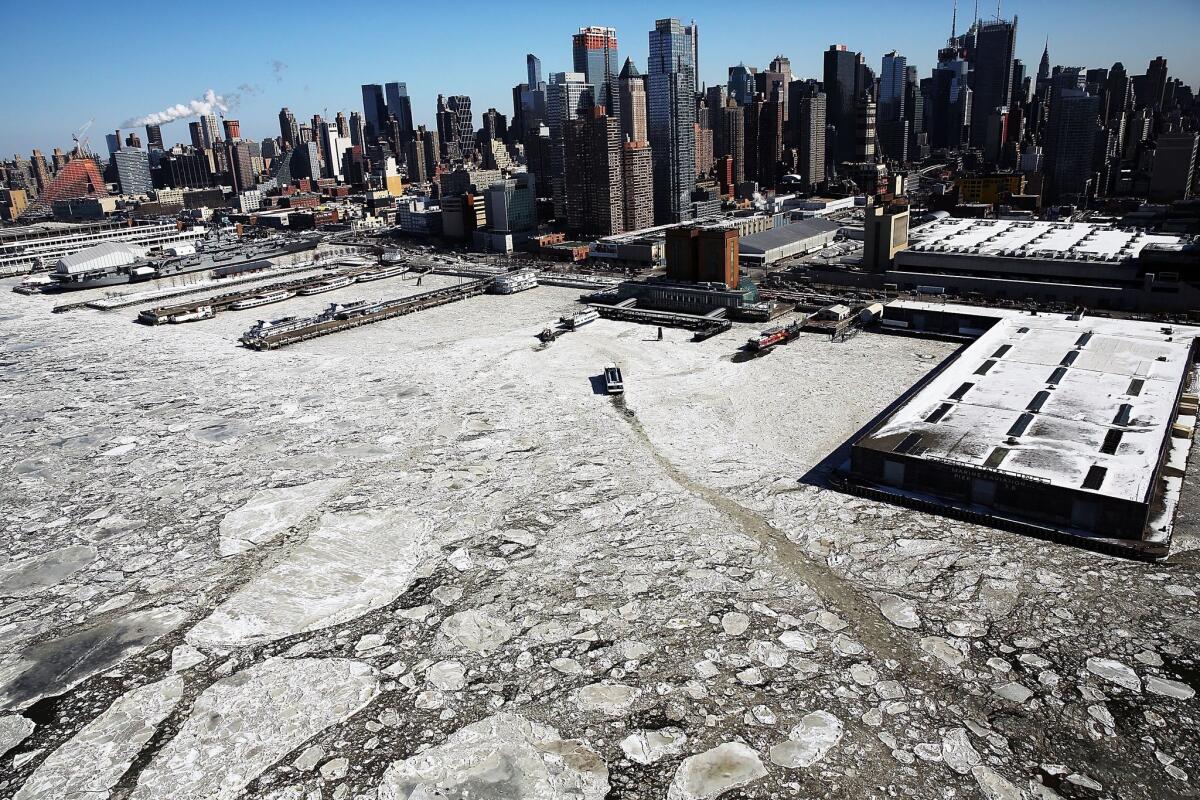Hot and cold winter: West and East coasts get extreme

- Share via
Whether it is public transportation, bragging rights to being the King of Cool or even pastrami, New Yorkers and Angelenos can be like the Hatfields and the McCoys. But they have found common ground this winter in grousing about the same thing: very different but harsh weather.

Source: National Climactic Data Center
In this winter of our discontent, the Left and Right coasts have found themselves dealing with opposites. The West has been way too warm and too dry, continuing years of drought. The East has been way too cold and too wet, with a series of blizzards piling even more snow onto mountainous drifts.
“I’m a California kid, I can’t imagine living through a blizzard,” said Ryan Kittell, a meteorologist with the National Weather Service in Los Angeles. “I’ve experienced snow and freezing rain, but it’s another thing to live through it.”
“Weather patterns happen in waves,” Kittell said. “If we are having nice weather here in California, then it makes sense to have something on the opposite end in the East. It makes sense it would be the opposite at the other end of the country. That’s the way works. It averages out across the country.”
Despite the recent extremes, it has been a warmer-than-average January in the United States, with temperatures 1.4 degrees above the average for the 20th century, according to the statistics compiled by National Oceanic and Atmospheric Administration. Meteorologists calculated that the United States in January was 2.9 degrees warmer than normal, making it the 24th warmest since 1880.
There were 3,499 daily warm temperature records broken in January, compared with 775 cold ones, according to the report.
California to rest of iced-over country: In your face!
“Averages is a good way to look at things,” said David Stark, Kittell’s counterpart in New York.
In an old vaudeville joke, a man is sitting on a block of ice with his hand on the burner of a stove. He is asked how he feels and exclaims: “On average, I’m feeling fine!”
The point, of course, is that an average can often hide the depth of current pain.
For example, Los Angeles was bracing for a weekend of alternating sun and clouds with a chance Sunday of rain, desperately needed as California and the West enter the fourth year of drought. Temperatures are expected to be in the high 60s to low 70s, warm enough for almost any kind of outdoor activity.
California in December and January were "record-breaking hot and extremely dry" for a rainy season, said Bill Patzert, a climatologist at the Jet Propulsion Laboratory in La Cañada Flintridge, California.
By contrast, New York was set for another weekend of nasty wintry slush, a mix of snow, freezing rain and dangerous cold that was gripping much of the nation and the South. Wind chills in New York were predicted to be between zero and 10 degrees overnight and 2 to 4 inches of snow was expected in the city that is having one of its nastiest winters ever.
So far in New York, there has been about 24.2 inches of snow, enough to make parents weary of dealing with children on snow days and even to make the suspension of parking regulations seem not to be worth the pain.
That roughly 2 feet of snow is more than in recent years, which has been about 7 inches. Over the long-term, about 26 inches per year is typical, Stark said.
The amount of snow varies across the region with the eastern parts of Long Island having received about 40 inches, more in line with New England. A relentless string of storms has pushed Boston snowfall within 1 foot of its all-time record for an entire winter as weather systems carry more snow east and north.
The temperatures have made this season especially nasty in New York. December was especially mild, but February has been especially cold, some 9 degrees colder, a fairly significant drop, Stark said.
In California, this year is shaping up as one of the warmest, Kittell said. But the lack of precipitation is the real story, he added.
“We had a decent amount of rain in December and January, just below what we normally get,” Kittell said. “But we haven’t had any real rain in February.”
Downtown Los Angeles has received .02 inches of rain this month, when typical rainfall totals 2.56 inches. All told, Los Angeles is about 4 inches below where it should be, he said.
The extreme temperatures have early Easter lilies pressing to the sky in the West while crocuses remain safely buried in the East.
It has been so dry in the West that San Francisco had no rain in January for the first time in 165 years, while for fun Bostonians were jumping from windows into feathery snowdrifts.
Twitter: @latimesmuskalSign up for The Wild
We’ll help you find the best places to hike, bike and run, as well as the perfect silent spots for meditation and yoga.
You may occasionally receive promotional content from the Los Angeles Times.




